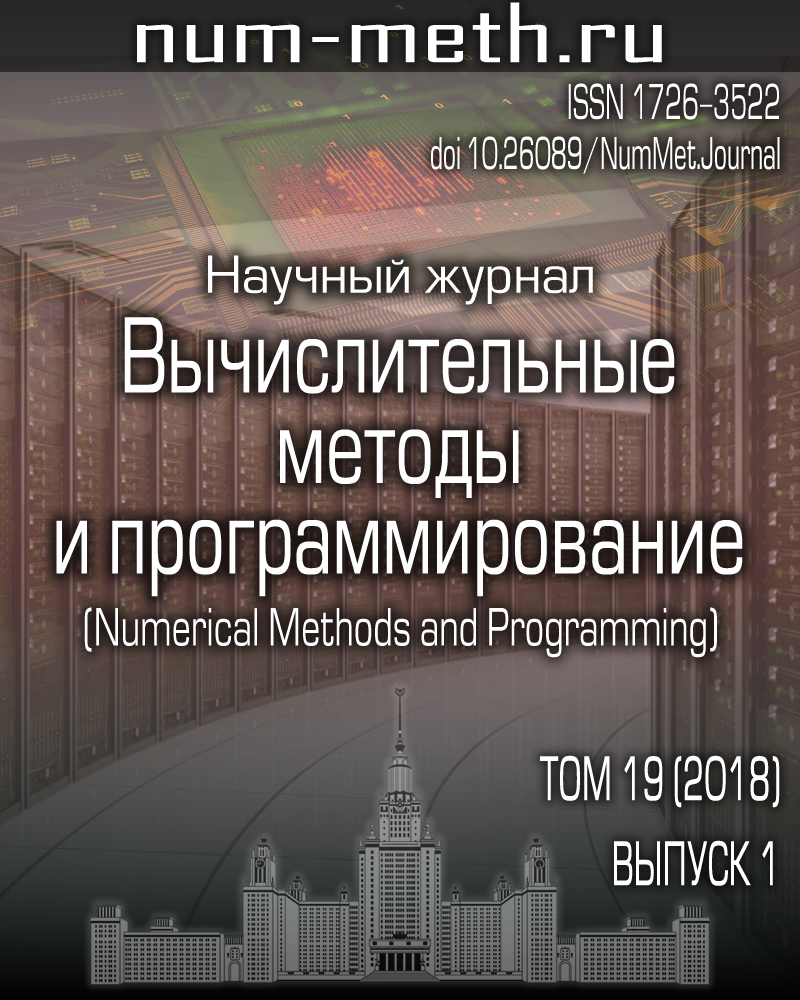DOI: https://doi.org/10.26089/NumMet.v19r107
Алгоритмическая цепочка для прямого персонифицированного моделирования ЭКГ и оценка времени ее работы
Ключевые слова:
сегментация медицинских изображений
персонифицированные модели
текстурный анализ
прямое моделирование ЭКГ
Аннотация
Предложена последовательность алгоритмов, позволяющая реализовать прямое моделирование электрокардиографии с использованием данных об индивидуальных анатомических особенностях пациентов. Приведенная цепочка включает в себя алгоритмы сегментации медицинских изображений, построения расчетной сетки и решения прямой задачи электрокардиографии. Реализовано ускорение алгоритмов сегментации и решения прямой задачи электрокардиографии. Дана оценка времени работы предложенной последовательности алгоритмов.
Опубликован
2018-02-25
Выпуск
Раздел
Раздел 1. Вычислительные методы и приложения
Библиографические ссылки
- L. Rineau and M. Yvinec, “A Generic Software Design for Delaunay Refinement Meshing,” Comp. Geom. Theory Appl. 38 (1-2), 100-110 (2007).
- Yu. V. Vasilevskii, A. A. Danilov, K. N. Lipnikov, and V. N. Chugunov, Automatized Technologies for Constructing Unstructured Computational Grids (Fizmatlit, Moscow, 2016) [in Russian].
- CGAL 4.11 - 3D Mesh Generation, User Manual.
https://doc.cgal.org/latest/Mesh_3/index.html . Cited February 13, 2018. - Advanced Numerical Instruments 3D.
https://sourceforge.net/projects/ani3d . Cited February 13, 2018. - J. Sundnes, B. F. Nielsen, K. A. Mardal, et al., “On the Computational Complexity of the Bidomain and the Monodomain Models of Electrophysiology,” Ann. Biomed. Eng. 34 (7), 1088-1097 (2006).
- F. B. Sachse, M. Wolf, C. Werner, and K. Meyer-Waarden, “Extension of Anatomical Models of the Human Body: Three-Dimensional Interpolation of Muscle Fiber Orientation Based on Restrictions,” J. Comput. Inf. Techn. 6 (1), 95-101 (1998).
- A. V. Strutynsky, Electrocardiogram: Analysis and Interpretation (MEDPress-inform, Moscow, 2012) [in Russian].
- R. C. Gonzalez and R. E. Woods, Digital Image Processing (Prentice-Hall, Upper Saddle River, 2006).
- A. Buades, B. Coll, and J.-M. Morel, “A Non-Local Algorithm for Image Denoising,” in Proc. 2005 IEEE Conf. on Computer Vision and Pattern Recognition, San Diego, USA, June 20-25, 2005 (IEEE Press, Washington, DC, 2005), Vol. 2, pp. 60-65.
- A. Buades, B. Coll, and J.-M. Morel, “Non-Local Means Denoising,” Image Processing On Line 1, 208-212 (2011).
doi 10.5201/ipol.2011.bcm_nlm - Amira for Life Sciences. 3D Visualization and Analysis Software.
https://www.fei.com/software/amira-3d-for-life-sciences/. Cited February 13, 2018. - gputools - OpenCL Accelerated Volume Processing in Python.
https://github.com/maweigert/gputools . Cited February 13, 2018. - R. M. Haralick, K. Shanmugam, and I. Dinstein, “Textural Features for Image Classification,” IEEE Trans. Syst. Man Cybern. SMC-3} (6), 610-621 (1973).
- ITK-SNAP.
http://www.itksnap.org . Cited February 13, 2018. - Convert3D Medical Image Processing Tool.
https://sourceforge.net/projects/c3d . Cited February 13, 2018. - P. A. Yushkevich, J. Piven, H. C. Hazlett, et al., “User-Guided 3D Active Contour Segmentation of Anatomical Structures: Significantly Improved Efficiency and Reliability,” Neuroimage 31 (3), 1116-1128 (2006).
- A. Danilov, R. Pryamonosov, and A. Yurova, “Image Segmentation for Cardiovascular Biomedical Applications at Different Scales,” Computation 4 (3) (2016).
doi 10.3390/computation4030035 - R. E. Mason and I. Likar, “A New System of Multiple-Lead Exercise Electrocardiography,” Am. Heart J. 71 (2), 196-205 (1966).
- D. U. J. Keller, F. M. Weber, G. Seemann, and O. Dössel, “Ranking the Influence of Tissue Conductivities on Forward-Calculated ECGs,” IEEE Trans. Biomed. Eng. 57 (7), 1568-1576 (2010).
- M. Hofer, CT Teaching Manual (Georg Thieme Verlag, Stuttgart, 2007; Meditsinskaya Literatura, Moscow, 2008).
- N. Zemzemi, M. O. Bernabeu, J. Saiz, et al., “Computational Assessment of Drug-Induced Effects on the Electrocardiogram: from Ion Channel to Body Surface Potentials,” Br. J. Pharmacol. 168 (3), 718-733 (2013).
- F. M. Weber, D. U. J. Keller, S. Bauer, et al., “Predicting Tissue Conductivity Influences on Body Surface Potentials - An Efficient Approach Based on Principal Component Analysis,” IEEE Trans. Biomed. Eng. 58 (2), 265-273 (2011).
- B. F. Nielsen, M. Lysaker, and P. Grøttum, “Computing Ischemic Regions in the Heart with the Bidomain Model - First Steps Towards Validation,” IEEE Trans. Med. Imaging 32 (6), 1085-1096 (2013).

